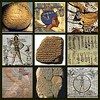The Creation Of Religious Beliefs And Their Evolutionary Patterns

After a couple of generations, the power of the burning rocks is well known to the tribe. They do not question the power. The power has been known to burn them, but only when they have been bad and done something against the wishes of the "special rocks". The tribe has collected many "burning rocks" and placed them in a special house where they can be protected, counted and have special oils sprinkled over them to keep them happy and content. The tribe has prospered. It now has many rituals concerning the special burning rocks with magnificent powers. They ask the powerful rocks special questions about the world. They lower themselves to the special rocks as they lower themselves to the head of the tribe, because they know that the special rocks could use their power against the tribe if they were displeased with them. The leader of the tribe also bends his body to the powerful rocks because he wants to remain the leader. He speaks to the rocks under his breath and asks them to be his ally and support him in the upcoming war against the people who follow the "power of the water." And so on and so forth. Superstitious minds create answers. For a comprehensive understanding of how people create gods through superstition, it is a good idea to study the evolution of religions. Start at animism and move on from there.
Basically, religious beliefs seem to have an evolutionary pattern. Just as other areas of human study and interest have an evolutionary pattern where information is discarded, edited, added to and poked and prodded until it reflects the culture, geography and the politics from which the belief has its roots. God belief or belief in invisible supernatural forces had its origins in primitive explanations for the phenomena demonstrated in the natural world. So, some of the first explanations for the inexplicable demonstrations of the natural world were animistic. That is, that powerful, invisible supernatural forces were present in living and non-living things. So, a rock which may have a specific property which didn't have a scientific explanation - say the rocks which burnt better than other rocks, would be attributed with "special powers" that other rocks did not have. These special powers could also be transported in mysterious ways into other objects, for example, the bright "fire plumage" of a passing parrot. People who wanted to harness this mysterious power would have created talismans or fetishes which they could either wear or keep close to their person. So, objects became talismans or amulets to ward off the obvious potential dangers which come about from living in a natural world.
The wearing of talismans is a form of fetishism. It is where the object worn is believed to have special magical powers. A lucky rabbit's foot is a form of fetishism. Supposedly lucky for us, but not too lucky for the rabbit. The superstitious belief is that it inherently wards of bad luck because of some unknown but assumed property associated with "fleet of foot." So people believed that as the rabbit was fast and elusive, so could they evade bad luck. The wearing of talismans like crosses, celtic symbols and a myraid of other religious symbols are examples of fetishism and are present in both modern and ancient religions. As people became more tribal, more specifically cultural in their beliefs, they created totems which represented the "special forces" which protected their tribe. So, the attributes attributed to various living things and non-living things became part of religious rituals which became tribe specific.
Consequently, the totem animals of the early peoples in North America, differ greatly from the animals to which the Australian aborigines attributed special powers. Every society has sought to provide answers to things they could not understand. If the reason for an occurrence was not obvious, it must have been something unseen. So the unseen became the reason for why things were happening. The evolution of the belief in "special powers" which exist in nature which could be harnessed by humans to solve human problems is continued through the processes of theriomorphism, zoomorphism and anthropomorphism.
Anthropomorphism is the attribution of human motivation, characteristics, or behaviour to inanimate objects, animals, or natural phenomena. Theriomorphism is the ascription of animal characteristics to humans or other natural phenomena. It is the belief that gods, or some mysterious inexplicable entities had animal physical represntations, such the wings on an angel, for example. Similar to an anthropomorphism, a zoomorphism is a figure of speech which ascribes animal characteristics to a mysterious power or to a god or supernatural entity. The purpose of a zoomorphism is give us an understanding of an aspect of a god by using an illustration of an animal characteristic. Eg. - "He will cover you with His pinions, and under His wings you may seek refuge; His faithfulness is a shield and bulwark." - (Psalm 91:4)
So zoomorphism is the attribution of animal characteristics or qualities to a god and the use of animal forms in symbolism, literature, or graphic representation. Human beings specialise in the 'arts of zoomorphism, theriomorphism and anthropomorphism' and they are evidenced throughout human history in our literature, fine arts, music, dance and religions. By anthropomorphising an animal we alter its contextual meaning within the human world. It becomes a symbol of something else, even though in essence it may retain its former appearance. Its prescriptors change as it takes on the characteristics and attributes of humans in the esoteric world of symbolism. Symbolism can suggest intangible conditions or "truths by artistic invention" Humans use these symbol-making skills in an attempt to explain intangible conditions. (For example: If one knows little about fertility but has observed that pigs are particularly successful at breeding; the 'artistic invention' of creating an amulet of a sow to wear around the neck, or of creating a 'Pig Goddess' to plead one's case to, is an example of fetishism and deification.
Some degree of anthropomorphism, theriomorphism or zoomorphism is characteristic of many religions and philosophies. Evidence of these human artistic inventions employed to understand the mysterious and the unknown are found in animism, animatism, totemism and fetishism. They are found in ancient legends, folklore, Egyptian, Greek and Roman mythology, Buddhism, Hinduism, Paganism, and Shamanism. And they are present in Christianity and Islam.
And then there is the human habit of personification which is similar to anthropomorphism. Personification, or personification anthropomorphism is a figure of speech that gives non-humans and objects human traits and qualities. These attributes may include sensations, emotions, desires, physical gestures, expressions, and powers of speech, among others. As a figure of speech it has a very long history; its Greek name is prosopopoeia. Pantheists, for example, personify the universe and all that is in it as a complete being which has human traits, feelings, emotions and responses. Thomas Paine, for example, believed that Christianity was the act of human beings personifying the sun. That is, that Jesus, was the personification of the sun, in human form. "The Christian religion is a parody on the worship of the Sun, in which they put a man whom they call Christ, in the place of the Sun, and pay him the same adoration which was originally paid to the Sun." - Thomas Paine
Anthropologists attempt to identify these forces at work. A british anthropologist, Sir Edward Burnett Tylor, argued in 'Primitive Culture' (1871) that animism is a primary source of anthropomorphic behaviour. Animism is the belief in personalized, supernatural beings that often inhabit ordinary animals and objects. It derives from people's self-conscious experience of the intangible, such as one's reflected image or dreams. Tylor describes it as the most primitive and essential form of religion. Essentially, where there has been an intangible, unknown condition, human beings have artistically invented explanations which ease their existential angst or their anxiety about life and their existence. The concepts of god have expanded with our expanding knowledge, and lack of knowledge of the universe. Where once, there were many separate discrete "forces" which competed for power and influence over humans, now we have aggregated them into one explanation - the concept of monotheism.
Where once there may have been a hierarchy of gods, and still is in polytheistic religious belief, there is now a preference for a "god dictatorship" or monotheism. Where once, the inexplicable was attributed to many separate, discrete "forces", it is now attributed, in the main, to one supernatural force. Our concepts of the supernatural and god may have expanded and evolved with our increasing knowledge, but they remain deeply rooted in our origins, where they were, to put it simply, "artistic inventions" of creative, evolving minds which sought to explain the unknown.
Sun of God?
![]() animatism ,
animatism , ![]() totemism ,
totemism , ![]() fetishism ,
fetishism , ![]() talisman ,
talisman , ![]() amulet ,
amulet , ![]() religion ,
religion , ![]() deification ,
deification , ![]() anthropomorphism ,
anthropomorphism , ![]() theriomorphism ,
theriomorphism , ![]() zoomorphism ,
zoomorphism , ![]() personification ,
personification , ![]() symbolism ,
symbolism , ![]() religious symbolism,
religious symbolism, ![]() supernaturalism ,
supernaturalism , ![]() animism
animism



















23 Comments:
I'm in. Bring me a fire rock to worship.
No fire rocks for you. You haven't paid your tithes to the "Fire Rock Priest" lately. ;)
You might want to at least note Cornelius Loew's "Myth, Scred History and Philosophy."
He traces the origin of religious sensibilities to "convictions."
Here's what he says:
Convictions that shape men's orientation to life are religious phenomena.... they are all persuasions about good and bad; about gods and devils; about representations of the ideal man, the ideal state, and the ideal society; about the meaning of history, nature, and the All. .... The decisive quality in the experience of being convinced we will call the quality of ultimacy, the quality that causes men to acknowledge that the objective referent has final authority over them...
Hello, this is a very nice blog. I like Arthur Dent too, my blog address is arthurdent.blogcu.com
Good work, nice to meet you...
gadfly:
Here's what he says:
After the Feuerbach fiasco, I really don't trust anything you quote anymore.
KA
I think we are about even.
Yes, I found your Feuerbach quotes interesting. Not knowing anything about him I looked up an article on him in a reference work and misread the paragraph. The quote was from a footnote. It was an honest mistake but I doubted you would believe it and you were having so much fun calling me names that I didn't want to spoil the moment.
You misread Trajan's response. It was an honest mistake. I just didn't call you any names.
As I said before - scoring points is not high on my conversational agenda. So far, I've learned something about Feuerbach and you've probably learned something about church history.
That's not bad for a conversation is it?
RE deniz:
Hi to Arthur Dent from "Hitchhiker's Guide to the Galaxy" - Let me know when the Vogons are going to destroy earth to make way for the new intergallactic bypass. ;)
RE gadfly:
Actually, I am more interested in the intellectual processes that humans make when confronted with an unknown.
Imagining that the universe and all the things in it, think, act, feel, emote and have the potential to behave as humans do, is I think, our biggest furphy.
Instead of detaching ourselves, our own feelings and thoughts how we would react to a given circumstance, we are continually assuming that the universe prescribes to a humanlike plan.
The scientific process is this potentially detached view. How we might feel as a human towards a hurricane or a tsunami (natural phenomena), is not relevant as to whether it has feelings or emotions towards us or whether it is mptivated by human feelings and desires.
The superstitious mindset spends inordinate amounts of time concentrating on how they believe the world, universe, and the invisible, FEELS about them.
The superstitious mindset lives in a world where they believe that the universe thinks like they do, and even that it is capable of thinking.
Beepbeep...good post. I hope you don't mind that I "borrowed" the video for a post at my blog (but gave you credit for finding it).
I have pondered these ideas for quite awhile, the idea of the interchange of son and sun...
It makes sense, since without the sun we cannot live. Our whole existence depends on the sun. And the sun is so bright that we cannot look at it, if we do it will blind us. It says something in the bible about not being able to look at the face of "god" because of the incredible brightness, and we would not be able to stand it. I would have to look that up to find the exact passages, if I find them I will come back and post them.
Here's one of the verses, there are more references to god and light, and not being able to look upon him.
“There is the Father, dwelling in the light which no man can approach unto, whom no man hath seen, nor can see; of such transcendent glory, of such all-consuming brightness of holiness, that no man could look upon Him and live. ” Exodus 33:20
I just want to know who plagiarized who this time?
RE BEAJ
I didn't plagiarize you as I posted mine yesterday, my time.
Maybe we have a psychic connection between goy and jew where we can both smell out BS at the same time? ;)
gadfly:
It was an honest mistake but I doubted you would believe it and you were having so much fun calling me names that I didn't want to spoil the moment.
No, you passed a test. You're a little bit of all right.
That's not bad for a conversation is it?
No, it ain't.
It is only logical that religion is an evolutionary process. Isn't it funny that so many people in this day & age are figuring that out? I don't mean intellectuals, but regular people like me.
The fact that we are evolving should give everyone hope.
Stardust
No worries, glad you liked it and thanks for the quotes.
LT
It makes sense to me too.
hey, I just watched the video. loved it!
Hey, Beep, haven't you sorted out all these God-botherers yet?
I have to admit getting onto your blog is not easy. It took me ten minutes to load the blog and one lot of questions. I don't have broadband of course so the problem is mine I guess.
What do you think about the nuclear war that will begin in the next few weeks? It might even take me longer to visit next time!
Of course, a lot of God-botherers are dancing in the streets thinking the Second Coming is just around the corner. However, what's waiting around the corner will not cause them much delight I'm afraid.
Cheers!
off topic:
http://tinyurl.com/2u6wjv
RE daniel
People like to believe all sorts of things and it is their right to do so. It certainly doesn't mean that I have to think what they believe is sensible though. ;)
Yes, I think the blog isn't all that easy to access on dial-up. Too many images maybe?
"What do you think about the nuclear war that will begin in the next few weeks? It might even take me longer to visit next time!"
Not much I can do about it if people are insane enough to go nuking each other over whose god has got the biggest penis. The truth doesn't prevail, politics does.
And I suppose if anything like that happens, there will be thousands of miserable fundies who didn't get raptured. But look on the bright side. We live in Australia and are likely to be nuked second and not first. lol
This is a " funny version of events." (Well, I think it is funny, but I have a warped sense of humour.
The End of the World
http://www.endofworld.net/
It might take a while to load on dialup.
Not much to say that hasn't already been said.
I like the video and borrowed and upped it on my blog, with your credit.
Hi-larry-us! ; ) Cheers!
Nicely put as usual Beep and an excellent video...:)
No worries coffee. Have fun with it.
RE ted
Thanks. It isn't the usual perspective that is for sure.
Post a Comment
<< Home